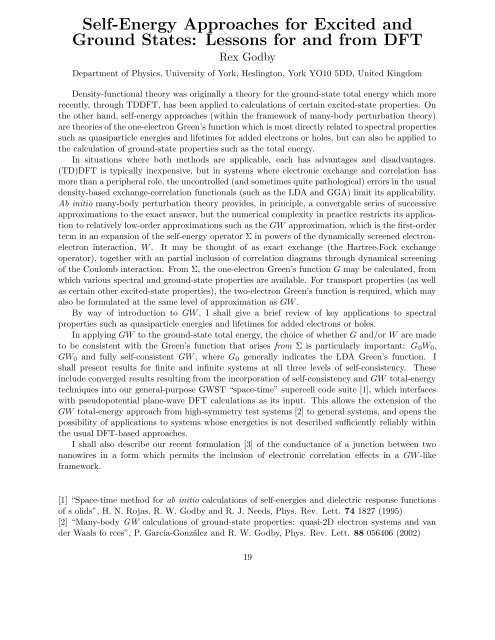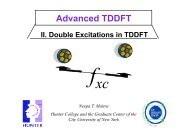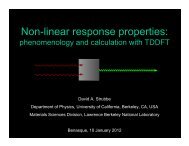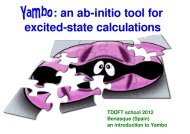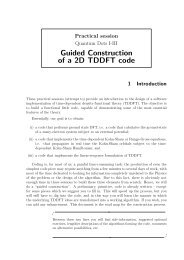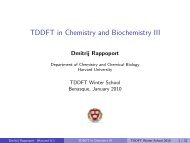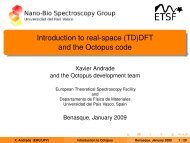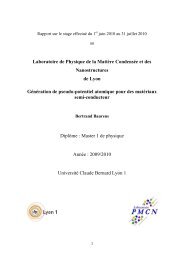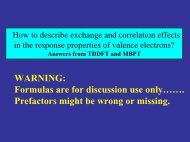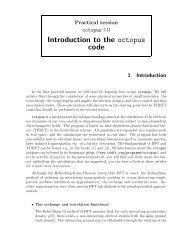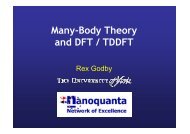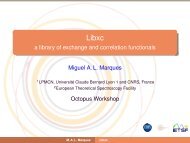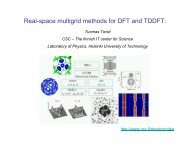TIME DEPENDENT DENSITY FUNCTIONAL THEORY ... - TDDFT.org
TIME DEPENDENT DENSITY FUNCTIONAL THEORY ... - TDDFT.org
TIME DEPENDENT DENSITY FUNCTIONAL THEORY ... - TDDFT.org
- No tags were found...
Create successful ePaper yourself
Turn your PDF publications into a flip-book with our unique Google optimized e-Paper software.
Self-Energy Approaches for Excited and<br />
Ground States: Lessons for and from DFT<br />
Rex Godby<br />
Department of Physics, University of York, Heslington, York YO10 5DD, United Kingdom<br />
Density-functional theory was originally a theory for the ground-state total energy which more<br />
recently, through <strong>TDDFT</strong>, has been applied to calculations of certain excited-state properties. On<br />
the other hand, self-energy approaches (within the framework of many-body perturbation theory)<br />
are theories of the one-electron Green’s function which is most directly related to spectral properties<br />
such as quasiparticle energies and lifetimes for added electrons or holes, but can also be applied to<br />
the calculation of ground-state properties such as the total energy.<br />
In situations where both methods are applicable, each has advantages and disadvantages.<br />
(TD)DFT is typically inexpensive, but in systems where electronic exchange and correlation has<br />
more than a peripheral role, the uncontrolled (and sometimes quite pathological) errors in the usual<br />
density-based exchange-correlation functionals (such as the LDA and GGA) limit its applicability.<br />
Ab initio many-body perturbation theory provides, in principle, a convergable series of successive<br />
approximations to the exact answer, but the numerical complexity in practice restricts its application<br />
to relatively low-order approximations such as the GW approximation, which is the first-order<br />
term in an expansion of the self-energy operator Σ in powers of the dynamically screened electronelectron<br />
interaction, W . It may be thought of as exact exchange (the Hartree-Fock exchange<br />
operator), together with an partial inclusion of correlation diagrams through dynamical screening<br />
of the Coulomb interaction. From Σ, the one-electron Green’s function G may be calculated, from<br />
which various spectral and ground-state properties are available. For transport properties (as well<br />
as certain other excited-state properties), the two-electron Green’s function is required, which may<br />
also be formulated at the same level of approximation as GW .<br />
By way of introduction to GW , I shall give a brief review of key applications to spectral<br />
properties such as quasiparticle energies and lifetimes for added electrons or holes.<br />
In applying GW to the ground-state total energy, the choice of whether G and/or W are made<br />
to be consistent with the Green’s function that arises from Σ is particularly important: G 0 W 0 ,<br />
GW 0 and fully self-consistent GW , where G 0 generally indicates the LDA Green’s function. I<br />
shall present results for finite and infinite systems at all three levels of self-consistency. These<br />
include converged results resulting from the incorporation of self-consistency and GW total-energy<br />
techniques into our general-purpose GWST “space-time” supercell code suite [1], which interfaces<br />
with pseudopotential plane-wave DFT calculations as its input. This allows the extension of the<br />
GW total-energy approach from high-symmetry test systems [2] to general systems, and opens the<br />
possibility of applications to systems whose energetics is not described sufficiently reliably within<br />
the usual DFT-based approaches.<br />
I shall also describe our recent formulation [3] of the conductance of a junction between two<br />
nanowires in a form which permits the inclusion of electronic correlation effects in a GW -like<br />
framework.<br />
[1] “Space-time method for ab initio calculations of self-energies and dielectric response functions<br />
of s olids”, H. N. Rojas, R. W. Godby and R. J. Needs, Phys. Rev. Lett. 74 1827 (1995)<br />
[2] “Many-body GW calculations of ground-state properties: quasi-2D electron systems and van<br />
der Waals fo rces”, P. García-González and R. W. Godby, Phys. Rev. Lett. 88 056406 (2002)<br />
19


